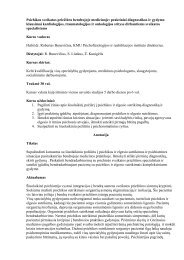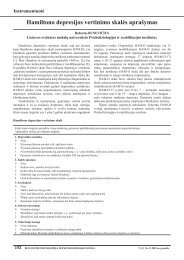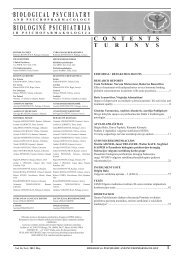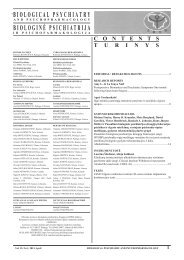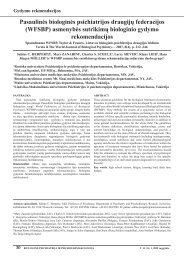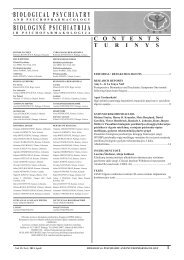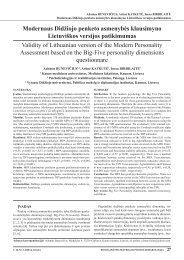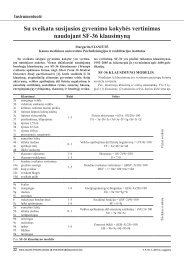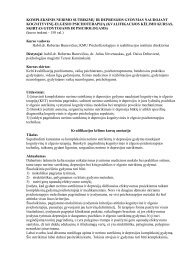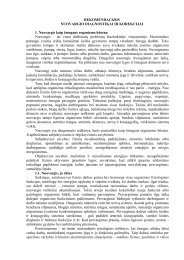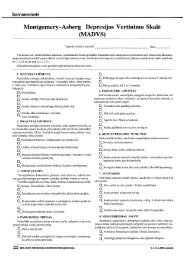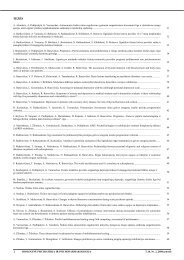biologinÄ psichiatrija - Psichofiziologijos ir reabilitacijos institutas ...
biologinÄ psichiatrija - Psichofiziologijos ir reabilitacijos institutas ...
biologinÄ psichiatrija - Psichofiziologijos ir reabilitacijos institutas ...
- No tags were found...
You also want an ePaper? Increase the reach of your titles
YUMPU automatically turns print PDFs into web optimized ePapers that Google loves.
Mokslo darbaiLITERATŪRA:1. Rozanski A., Blumenthal J.A., Davidson K.W., .W., Saab P.G., Kubzansky ubzansky L. The the epidemiology,pathophysiology, and management of psychosocial risk factors in cardiac practice: The emergingfield of behavioral cardiology // J Am Coll Cardiol. – 2005, vol. 45, p. 637–651.2. Rosengren A., Hawken S., Ounpuu S. et al. INTERHEART Investigators. Association of psychosocialrisk factors with risk of acute myocardial infarction in 11, 119 cases and 13,648 controlsfrom 52 countries (the INTERHEART study): case–control study // Lancet. – 2004, vol. 364, p.953–962.3. Januzzi J.L. Jr., Stern T.A., Pasternak R.C., DeSanctis R.W. The Influence of Anxiety and Depressionon Outcomes of Patients With Coronary Artery Disease // Arch Intern Med. – 2000, vol. 160,p. 1913–19214. Barefoot J.C., Helms M.J., Mark D.B. et al. Depression and long–term mortality risk in patientswith coronary artery disease // Am J Cardiol. – 1996, vol. 78, p. 613–617.5. Frasure–Smith N., Lesperance F., Talajic M. Depression following myocardial infarction // JAMA.– 1993, vol. 270, p. 1819–1825.6. Romanelli J., Fauerbach J.A., Buch D.E. & Ziegelstein R.C. The significance of depression inolder patients after myocardial infarction // Journal of the American geriatric Society. – 2002, p.50, p. 817–822.7. Task Force of the European Society of Cardiology and the North American Society of Pacing andElectrophysiology. Heart rate variability. Standards of measurement, physiological interpretationand clinical use // Eur Heart J. – 1996, 17, p. 354–381.8. Fletcher G.F., Balady G.J., Amsterdam E.A. et al. T. Exercise Standards for Testing and Training:A Statement for Healthcare Professionals From the American Heart Association // C<strong>ir</strong>culation.– 2001, vol. 104, p. 1694–1740.9. Žemaitytė D., Brožaitienė J., Žiliukas G. <strong>ir</strong> kt. Kardiovaskulinė reabilitacija / Universitetovadovėlis. – Kaunas, 2001.10. Malfatto G., Facchini M., Sala L., Branzi G., Bragato R., Leonetti G. Relationship between baselinesympatho–vagal balance and the autonomic response to cardiac rehabilitation after a f<strong>ir</strong>stuncomplicated myocardial infarction // Ital Heart J. – 2000, Mar., vol. 1, No 3, p. 226–232.11. Ades P.A. Cardiac rehabilitation and secondary prevention of coronary heart disease // N Engl JMed. – 2001, vol. 345, p. 892–902.12. Scholz U., Knoll N., Sniehotta F.F., Schwarzer R. Physical activity and depressive symptoms incardiac rehabilitation: Long–term effects of a self–management intervention // Social Science &Medicine. – 2006, vol. 62, p. 3109–3120.13. Lucini D., Milani R.V., Constantino G., Laviec J., Porta A., Pagani M. Effects of cardiac rehabilitationand exercise training on autonomic regulation in patients with coronary artery disease // AmHeart J. – 2002, vol. 143, No 6, p. 1–2.14. Sniehotta F.F., Scholz U., Schwarzer R., Fuhrmann B., Kiwus U. & Voller H. Long–term effects oftwo psychological intervention on physical exercise and self–regulation after coronary rehabilitation// International Journal of Behavioral Medicine. – 2005, vol. 12, p. 244–255.15. Cossette S., Frasure–Smith N., Lesperance F. Clinical Implications of a Reduction in PsychologicalDistress on Cardiac Prognosis in Patients Participating in a Psychosocial Intervention Program// Psychosom. Med. – 2001, vol. 63, p. 257–266.16. McAuley E., Kramer A.F., Colcombe S.J. Cardiovascular fitness and neurocognitive function inolder adults: a brief overview // Brain Behav Immun. – 2004, vol. 18, p. 214–220.17. Iellamo F., Legramante J.M., Massaro M., Raimondi G., Galante A. Effects of a Residential ExerciseTraining on Baroreflex Sensitivity and Heart rate Variability in Patients With Coronary ArteryDisease // C<strong>ir</strong>culation. – 2000, vol. 102, p. 2588–2592.18. Milani R.V., Lavie C.J. Prevalence and effects of cardiac rehabilitation on depression in the elderlywith coronary heart disease // Am J Cardiol. – 1998, vol. 81, p. 1233–1236.19. Babyak M., Blumenthal J.A., Herman S. et al. Exercise treatment for major depression: maintenanceof therapeutic benefit at 10 months // Psychosom Med. – 2000, vol. 62, p. 633–638.20. Lavie C.J., Milani R.V. Prevalence of anxiety in coronary patients with improvement followingcardiac rehabilitation and exercise training // Am J Cardiol. – 2004, vol. 93, p. 336–339.21. Vaičiūnienė B., Brožaitienė J., Juškėnas J. <strong>ir</strong> kiti. Ligonių po miokardo infarkto fizinio tren<strong>ir</strong>avimopoveikio vertinimas pagal š<strong>ir</strong>dies ritmo variabilumo, fizinio pajėgumo <strong>ir</strong> kraujotakos rodiklius //Sveikatos mokslai. – 2007, T. 1, Nr. 48, p. 716–718.Gauta: 2008 04 12Priimta spaudai: 2008 05 2320 Biologinė <strong>psichiatrija</strong> <strong>ir</strong> psichofarmakologija T. 10, Nr. 1, 2008 m. b<strong>ir</strong>želis



